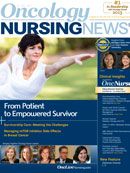Publication
Article
Oncology Nursing News
Survivorship Care-Meeting the Challenges
Author(s):
This third and final installment emanating from our roundtable with oncology nursing experts focuses on survivorship, now universally recognized as a crucial aspect of oncology care.
Panelists
Barbara Given, PhD, RN, FAAN
Director of PhD Program
Michigan State University College of Nursing
Ruth McCorkle, PhD, FAAN
Florence Schorske Wald Professor of Nursing
Yale School of Nursing
Helen C. Foley, MSN, RN, AOCNS
Clinical Faculty, Frances Payne Bolton School of Nursing at Case Western Reserve University
Clinical Nurse Specialist University Hospitals Seidman Cancer Center
Rebecca Kronk, PhD, CRNP, MSN
Assistant Professor
Duquesne University School of Nursing
Janine Overcash, PhD, GNP-BC
Director of Nursing Research at The James Cancer Hospital & Solove Research Institute Clinical Associate Professor The Ohio State University College of Nursing
EDITOR’S NOTE This third and final installment emanating from our roundtable with oncology nursing experts focuses on survivorship, now universally recognized as a crucial aspect of oncology care.
Ruth McCorkle (segment moderator): We have more than 13 million cancer survivors today. In 2005, the Institute of Medicine’s report, (From Cancer Patient to Cancer Survivor: Lost in Transition) made 10 recommendations, including that each cancer patient needs a survivorship plan because care is so fragmented, and the American Society of Clinical Oncology has published recommendations. What are some of the necessary components of a survivorship plan?
Rebecca Kronk: It is really important to keep in mind the whole goal of a survivorship plan: to maintain quality of life and also to empower the patient and family. The plan needs to be specific to the type of cancer and response to treatments. Another really important component is the support services (psychiatric, nutritional, etc) and referrals to resources in the patient’s community. These are the elements that will really support people as they move forward, as well as provide them with a “medical home,” per se, by coordinating care.
McCorkle: What are some of the challenges when a patient moves back to primary care? Palliative care isn’t just relief. It also involves prevention and endorsing a healthy lifestyle, including nutrition, exercise, and stress relief.
Barbara Given: Fragmentation is a huge problem. What happens is that the primary care physicians often feel unprepared to take the patients back, especially when they are continuing to have symptoms. The oncologists may be hesitant to release a patient from their care. We need to figure out how to involve the nurse practitioner in facilitating that transition back to primary care, with so many of the patients continuing to have symptoms and not having anyone to help them.
Helen Foley: This time of transition to survivorship also can be an opportunity for patients and families to change habits. It is a teachable moment. If we have as part of the plan new health behaviors and helping people to plan for their future—whether it is increasing exercise or changing diet—then the survivorship plan can work with the patient and the primary care doctor to set a path for the future.
Janine Overcash: Nurses are in a fabulous position to be part of this discussion and to be leaders in the success of the survivorship care planning. I am a geriatric nurse practitioner, and we are going to have our patients for a very long time; they are going to have comorbidities, with cancer being one of them. Nurses can help the patient and the family to foresee the path that they are going to take with managing other nonmalignant comorbidities, as well as with their cancer treatment plans.
McCorkle: How much should go into a survivorship plan?
Overcash: That is a very fluid discussion, and what goes into the plan is what we’re struggling with nationally. Do you put so much into it that it becomes so burdensome that it no longer has practicality? As clinicians, we know that something so large can be difficult to implement. I think it has to lie somewhere between practicality and a comprehensive approach.
Given: The research focuses mostly on whether we’re addressing all the checklist items. What the research is not doing, nor do we have enough knowledge of, is how if we focused on the residual and short-term effects during the transition, we could then better understand the late- and long-term effects. In addition, the family resources involved are virtually never in any plans.
Kronk: The research should be focused on the educational component as well. We have so many individuals who are now cancer survivors, and for medical schools, nursing schools, and physical therapy schools as well, we need to start to integrate this component into preparing these future healthcare providers. For example, if the diagnosis and treatment involve the central nervous system, what are some of the comorbid conditions that we need to be caring for and thinking about?
Overcash: There are some opportunities now for funding this research. Survivorship is on the agenda and in the scope of national organizations. We are now seeing government funding opportunities to help drive survivorship thought and survivorship care. I think in the next few years, we are going to see some changes and refinements in some of the care planning.
McCorkle: This is really good news. People are living longer. Our institution has recently transitioned to an EPIC (electronic patient information chart) medical record system that is going to be integrative from the inpatient to the outpatient. I think the long-term effects of this are going to be very positive in developing an automated system to include this information in the survivorship planning.







%20(2)%201-Recovered-Recovered-Recovered-Recovered-Recovered.jpg?fit=crop&auto=format)

%20(2)%201-Recovered-Recovered-Recovered-Recovered-Recovered.jpg?fit=crop&auto=format)
%20(2)%201-Recovered-Recovered-Recovered-Recovered-Recovered.jpg?fit=crop&auto=format)